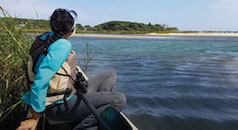 As some of nature’s most ambitious and amazing long-distance migrants, shorebirds travel thousands of miles over the course of their annual migration and are dependent on a network of key areas in which to rest and “refuel” throughout their lifecycle. In the early 1980s, scientists in the Americas began documenting serious declines in shorebird populations, which led to recognition of the need for a site-specific, hemisphere-scale conservation strategy.
As some of nature’s most ambitious and amazing long-distance migrants, shorebirds travel thousands of miles over the course of their annual migration and are dependent on a network of key areas in which to rest and “refuel” throughout their lifecycle. In the early 1980s, scientists in the Americas began documenting serious declines in shorebird populations, which led to recognition of the need for a site-specific, hemisphere-scale conservation strategy.
This vision was formalized in 1985 with the creation of the Western Hemisphere Shorebird Reserve Network (WHSRN). WHSRN follows a simple idea: to sustain healthy populations of shorebirds, we must maintain the ecological integrity of the key sites that provide the habitats and nourishment they need for survival.
This year is the beginning of a three-year-long 30th anniversary for WHSRN. 2016 will mark the anniversary of the designation of the first WHSRN site: Delaware Bay in USA, and 2017 will represent the anniversary of when an actual “network” was formed with the designation of a second site, the Bay of Fundy, in New Brunswick, Canada. To date, WHSRN site partners are conserving more than 32 million acres (>13 million hectares) of shorebird habitat across 92 sites in 14 countries.

The WHSRN team from left to right: Manomet President John Hagan, WHSRN Information Associate Lisa Schibley, Vice President of Shorebird Conservation Stephen Brown, WHSRN Community Engagement Coordinator Laura Chamberlin, Director of WHSRN Executive Office Rob Clay, WHSRN Conservation Specialist Meredith G. Morehouse, and WHSRN Conservation Specialist Diego Luna Quevedo.
Manomet houses the Executive Office for WHSRN, which provides administrative, technical, and outreach services to sites, including coordination and communication between sites. But the real impact of the Network comes from the partners on the ground who each day are working to improve conservation at their sites.
After a WHSRN-led site status and threat assessment workshop and follow-up surveys identified community engagement as a priority in the Delaware Bay region, the Executive Office has been working with local site partners to expand conservation efforts there. With a focus on moving the local community from awareness to taking action, this year alone, the Delaware Bay Program Coordinator Laura Chamberlin helped provide 1,200 people with a hands-on educational, stewardship, or citizen science experience; coordinated the rescue of over 30,000 horseshoe crabs; engaged 46 leaders for conservation action; and worked with youth to create 15 beach signs to reduce human disturbance of shorebirds on beaches.

Beach signs by children in Delaware Bay.
In 2011, the Eastern Wetlands of Chiloé, off the coast of southwest Chile, were collectively designated a WHSRN Site of Hemispheric Importance for supporting more than 40% of the world’s population of Hudsonian Godwits. Since then, WHSRN Conservation Specialist Diego Luna Quevedo has led the development of a Shorebird Conservation Plan for this site with local partners. He has been building a foundation for good governance with municipalities and communities,leading to marine concessions (rights to manage the area for shorebirds), ordinances, municipal reserves, and habitat management agreements that benefit shorebirds. Other strategies involve combining conservation and new economic opportunities for local people. Additionally, strengthening local capacities and implementing environmental education programs, festivals, and social marketing campaigns have helped local communities recognize the economic value of protecting shorebirds and their wetland habitats.

An amazing scene of shorebirds in Chiloé captured by Diego Luna Quevedo.
Under the strategic direction of its governance body, the Hemispheric Council, the WHSRN Executive Office continues to strive to enhance the effectiveness of the Network. Opportunities in the coming year will be focused on strengthening the value of a WHSRN designation through: greater connectivity and sharing of experiences among sites; identifying and addressing “gaps” in the Network in places of greatest ecological need for shorebirds; and promotion of “shorebird friendly” products and activities at WHSRN sites (e.g., salt, shrimp, beef, rice, and ecotourism).
As the first year of the 30th anniversary for WHSRN winds to an end, take a look at the map of sites. You will see a constellation shaped much like the hemisphere, each dot a critical place for a shorebird—whether as a winter haven, brief rest stop, or a site for nesting. But this constellation is only as strong as its willing partners, each committed to doing their part to help sustain healthy shorebird populations.
Map of WHSRN sites.
Many people and organizations help to make WHSRN thrive. We would like to thank Bobolink Foundation, Canadian Wildlife Service, Geraldine R. Dodge Foundation, David and Lucile Packard Foundation, William Penn Foundation, Mattina R. Proctor Foundation, National Fish and Wildlife Foundation, U.S. Fish and Wildlife Service, U.S. Forest Service-International Programs and the many individual donors for their support to WHSRN this year.
You can help build and strengthen our constellation by making a donation to WHSRN today. Do you live near a WHSRN site? Have you visited others, or plan to? Check the map and tell us about it on our Facebook page! To stay informed about WHSRN news and events, subscribe to WHSRNews, the monthly e-newsletter which is also available in Spanish.





 Back to all
Back to all